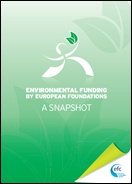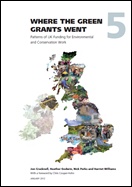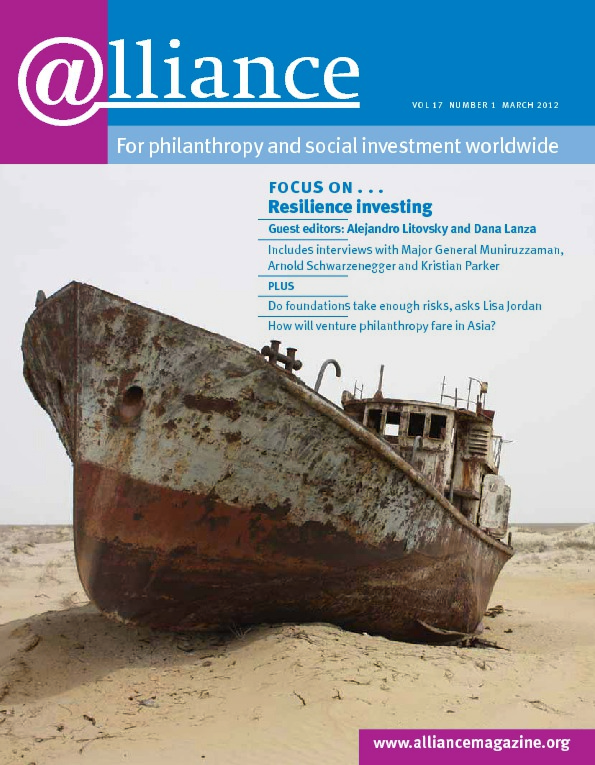 In September 2011 the European Foundation Centre published a new report looking at the state of environmental philanthropy across EU member states. Environmental Funding by European Foundations: A snapshot forms part of a growing set of research on environmental philanthropy around the world. Both it and its UK counterpart, Where The Green Grants Went 5, provide overviews of the environmental performance of a range of countries, and in doing so raise questions about where philanthropic funds can most effectively be spent. What emerges most clearly is that grants should be moving eastwards.
In September 2011 the European Foundation Centre published a new report looking at the state of environmental philanthropy across EU member states. Environmental Funding by European Foundations: A snapshot forms part of a growing set of research on environmental philanthropy around the world. Both it and its UK counterpart, Where The Green Grants Went 5, provide overviews of the environmental performance of a range of countries, and in doing so raise questions about where philanthropic funds can most effectively be spent. What emerges most clearly is that grants should be moving eastwards.
Looking at the EU, it is clear that there is a gulf in environmental awareness between northern Europe and many central and eastern European member states. In the five member states with the highest awareness of climate change, almost 76 per cent of the public feel they are well-informed, while in the five with the lowest awareness the corresponding figure is just 32.7 per cent. There are similar disparities in citizens’ involvement in environmental organizations, and in the extent to which the public hold ‘post-materialist’ values, where material possessions are seen as less important in life.
The research shows that environmental grants from European foundations are currently concentrated in countries like the Netherlands and the UK, which already perform relatively well on metrics of environmental policy and have no shortage of environmental groups. Given that EU environmental policy is the result of negotiations between all 27 member states, shouldn’t European environmental foundations be actively investing in countries with lower environmental awareness and fewer environmental organizations?
 The research also shows that only a small share of grants are directed towards environmental initiatives in emerging economies such as China (pictured: sunset in Shanghai through the smog; taken from the top of the Jin Mao tower), which received just 12 of the 791 grants that were coded. Shouldn’t foundations be moving resources systematically eastwards to countries that are deciding whether to follow or leapfrog the West’s ‘dirty’ development path? These countries currently lack depth in their domestic philanthropic infrastructure, for understandable reasons, yet the decisions they are taking will affect everyone in the world.
The research also shows that only a small share of grants are directed towards environmental initiatives in emerging economies such as China (pictured: sunset in Shanghai through the smog; taken from the top of the Jin Mao tower), which received just 12 of the 791 grants that were coded. Shouldn’t foundations be moving resources systematically eastwards to countries that are deciding whether to follow or leapfrog the West’s ‘dirty’ development path? These countries currently lack depth in their domestic philanthropic infrastructure, for understandable reasons, yet the decisions they are taking will affect everyone in the world.
 Money isn’t everything when it comes to environmental policy success. For example, US environment groups had combined revenues in 2008 of $11.3 billion, yet the US ranks 61st in the world in environmental performance. More research is undoubtedly needed into the links between NGO resourcing and good policy outcomes. However, the data now being gathered suggests the need for a geographical re-orientation of grantmaking, informed by analysis of the changing geopolitics of the environment.
Money isn’t everything when it comes to environmental policy success. For example, US environment groups had combined revenues in 2008 of $11.3 billion, yet the US ranks 61st in the world in environmental performance. More research is undoubtedly needed into the links between NGO resourcing and good policy outcomes. However, the data now being gathered suggests the need for a geographical re-orientation of grantmaking, informed by analysis of the changing geopolitics of the environment.
Jon Cracknell is director of the JMG Foundation. Email jon@jmgfoundation.org
Marilena Vrana is interest groups coordinator at the EFC. Email mvrana@efc.be
Further reading
Marilena Vrana and Jon Cracknell (2011) Environmental Funding by European Foundations: A snapshot, Brussels: EFC.
http://www.efc.be/Networking/InterestGroupsAndFora/Environment/Documents/efc_environmental_final.pdf
Jon Cracknell et al (January 2012) Where the Green Grants Went 5, Environmental Funders Network http://www.greenfunders.org





Comments (0)